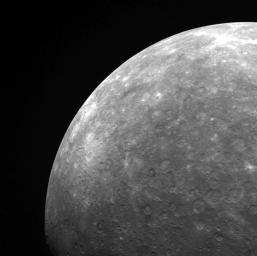
|
It All Ends at Mercury’s Limb
- Click the image above for a larger view
- Full-Res JPEG (1024 x 1020) (102.4 kB)
- Full-Res TIFF (1024 x 1020) (1.0 MB)
Caption:
In this limb image of Mercury's southern hemisphere, the enormous Rembrandt basin is visible in the lower left; bright Amaral crater, above Rembrandt in this image, also stands out. Towards the middle of the image is Sher-Gil , a dark-haloed crater.
This image was acquired as part of MDIS's limb imaging campaign. Once per week, MDIS captures images of Mercury's limb, with an emphasis on imaging the southern hemisphere limb. These limb images provide information about Mercury's shape and complement measurements of topography made by the Mercury Laser Altimeter (MLA) of Mercury's northern hemisphere.
Date acquired:
June 28, 2011
Image Mission Elapsed Time (MET):
217715590
Image ID:
433835
Instrument:
Wide Angle Camera (WAC) of the Mercury Dual Imaging System (MDIS)
WAC filter:
7 (748 nanometers)
Center Latitude:
-29.49°
Center Longitude:
133.6° E
Resolution:
2792 meters/pixel
Scale:
Mercury's radius is approximately 2440 km (1516 miles)
Incidence Angle:
46.3°
Emission Angle:
48.0°
Phase Angle:
68.9°
Background Info:
The MESSENGER spacecraft is the first ever to orbit the planet Mercury, and the spacecraft's seven scientific instruments and radio science investigation are unraveling the history and evolution of the Solar System's innermost planet. Visit the Why Mercury? section of this website to learn more about the key science questions that the MESSENGER mission is addressing.
These images are from MESSENGER, a NASA Discovery mission to conduct the first orbital study of the innermost planet, Mercury. For information regarding the use of images, see the MESSENGER image use policy .
Cataloging Keywords:
| Name | Value | Additional Values |
|---|---|---|
| Target | Mercury | |
| System | ||
| Target Type | Planet | |
| Mission | MESSENGER | |
| Instrument Host | MESSENGER | |
| Host Type | Orbiter | |
| Instrument | Mercury Dual Imaging System (MDIS) | |
| Detector | Wide Angle Camera (WAC) | |
| Extra Keywords | Crater, Grayscale, Radio | |
| Acquisition Date | ||
| Release Date | 2011-07-14 | |
| Date in Caption | 2011-06-28 | |
| Image Credit | NASA/Johns Hopkins University Applied Physics Laboratory/Carnegie Institution of Washington | |
| Source | photojournal.jpl.nasa.gov/catalog/PIA14463 | |
| Identifier | PIA14463 | |
